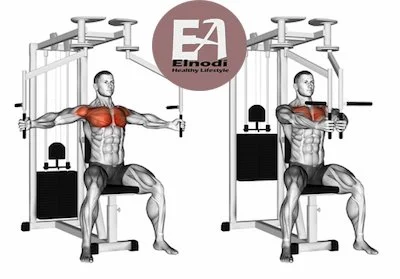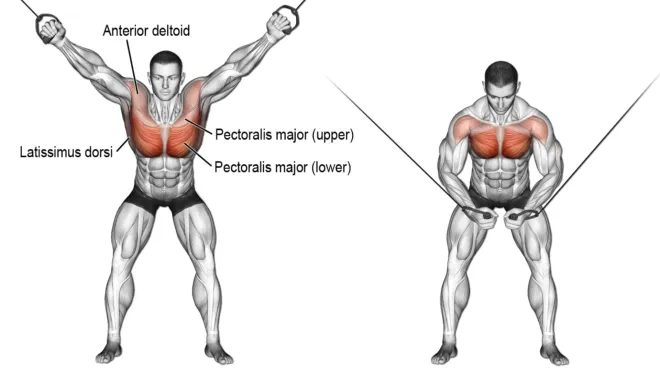Get toned and strong arms with this top-rated chest fly machine exercise. This exercise will help sculpt your upper body quickly!
Looking to tone your chest? Fly machines are a great way to do this and provide a variety of resistance levels. Whether you’re new to the concept or just looking for a change of pace, this guide will present you with the best chest fly machine exercises.
Fly machines have been around for many years and have become one of the most popular exercise machines for weight loss and toning. They offer a high-intensity workout that is perfect for people who are short on time. Plus, there are dozens of different types of fly machines out there, so you can find one that is perfect for your needs.
If you’re looking to tone your chest, here’s a list of the best chest fly machine exercises – based on customer ratings and reviews.
Introduction to the Machine Chest Fly
The resistance curve in machine chest flies is more evenly distributed than the dumbbell chest flies, and you’ll have more of a constant load on your chest muscles throughout the whole range of motion. It’s easy to learn and suitable for lifters at all levels.
Which Muscles Do the Machine Chest Fly Work?
The machine chest fly primarily works the chest muscles, but it also activates the front deltoids.
The pectoralis muscles, or chest muscles, are placed on the front of the chest. They are in charge of pushing actions like pressing a barbell or dumbbell above. The two most important chest muscles are:
The largest chest muscle is the pectoralis major. It spreads down to the belly and covers the majority of the front of the chest.
Pectoralis minor: A lesser muscle located beneath the pectoralis major. It aids in the stabilization of the shoulder joint.
The front deltoids are found in front of the shoulders. They are in charge of lifting the arms overhead and spinning them forward.
When you do a machine chest fly, your chest muscles flex to bring the machine’s grips together in front of your chest. The front deltoids also contract to aid in shoulder stability.
Benefits of Chest Fly Machine
The fly machine is ideal for increasing chest strength and muscle mass by targeting the pectoralis muscles. You have two sets of pectoral muscles on each side of the front of your chest: the pectoralis major and the pectoralis minor. This exercise primarily benefits the pectoralis major—the larger of the two muscles that are responsible for movement at the shoulder joint.
You use these muscles for many day-to-day activities, such as pushing open a heavy door, picking up a heavy grocery bag, or lifting a child. The pectoralis muscles also control the chest and ribcage when you take a deep breath.
This exercise is particularly helpful if you are new to training these muscles. The chest fly is performed fully seated and supported by a back pad so it is easy to practice good posture and form while using the machine. Additionally, the seated position helps you put your full effort into the chest muscles.
Like other strength-building exercises, the chest fly machine can help build lean body mass and bone density, as well as increase base metabolic rate.
Chest Fly Machine
Chest fly machine exercises are an excellent approach to focus your pecs. They are a compound exercise, which means they work for several muscular groups at once. Chest fly machine movements engage your shoulders, triceps, and anterior deltoids in addition to your chest.
To perform a chest fly machine workout, sit on the machine and adjust the seat so your arms are extended and parallel to the floor. Hold the handles with your palms facing each other. Bring your arms in front of your chest slowly, keeping your elbows slightly bent. After a brief pause, progressively return to the beginning position.
Chest-Seated Pec Fly Machine

The performer must sit upright on the machine and press the handles in front and towards the body to fly the machine. When seated, adjust the seats so that the handles are at chest height, then move the handles so that they are in line with your shoulders. Setting them back further than this can put additional strain on the shoulder joint and increase the risk of injury.
The most difficult position is the stretched position at the start of the movement, which requires pec contraction to drive the grips together. There is less resistance as the handles are brought closer together. At this point, squeeze the pecs together tightly to keep the muscles engaged.
How To Do
- Pin a good lifting weight first, then adjust the seat height so that the arc of your arms is just below shoulder height when you take the position.
- Reach back for the machine handles one at a time, keeping your feet flat on the floor. Your core is firm, your back is pressed against the back pad, and your arms are outstretched, slightly angled back behind your body, palms forward. This is where you’ll begin.
- Squeeze your chest, bringing your outstretched arms together in front of your body at roughly the nipple line, for 1-2 seconds as you exhale. As your arms make a big arc from the shoulder joint, your body remains immobile. Pause for a split second near the end of the action, where the machine handles meet in the middle and the palms face each other.
- Inhale as you reverse the movement, bringing the chest back to full extension with arms outstretched. The chest muscle should be stretched and opened up completely.
Other Cable Chest Exercises
1. High Cable Fly (High To Low Cable Fly)

The High To Low cable fly is a chest fly variation that is perfect for targeting the bottom area of your chest.
The cable maintains consistent tension throughout the movement, resulting in maximal muscle activation and muscle growth and strength.
The high-to-low cable fly is a machine exercise that primarily targets the chest but also, to a lesser extent, the shoulders and triceps.
Muscles were used.
- Lower pectoralis major
- Secondary muscles include the upper chest, anterior deltoid, latissimus dorsi (back), biceps brachii, and rhomboids.
How To Do High Cable Fly
- Set both pulleys as high as possible and select the desired weight.
- In a standing position, grab the handles with a neutral grip.
- Bend slightly forwards, and extend your arms feeling a good stretch in your chest muscles.
- Bend your elbows slightly, and pull your hands (high to low) toward each other in wide arcs in front of you, pausing when your hands touch.
- Slowly lower back to the starting position and repeat for the desired number of repetitions.
2. Decline Cable Fly

One of the best exercises for isolating the lower chest muscles is the decline cable fly.
Using cables instead of dumbbells allows for consistent strain, which aids in the development of lower chest fibers. The Dumbbells cannot provide this consistent tension.
Muscles Worked
Main: Lower chest
Secondary muscles include the upper chest, anterior deltoid, and triceps.
How To Do Decline Cable Fly
- How to Fly a Decline Cable
- Set the Decline bench to a 30° angle. Place your feet flat on the foot pad or roller while lying down on the bench.
- Raise your arms straight up from your shoulders and cross your chest with the cable handle.
- Lower your arms out to your sides slowly until your wrists are at or just over shoulder level.
- Use your lower pec muscles to bring your arms back to the center of your body.
3. Cable Crossover

If you’re looking for simple cable machine chest workouts to add to your regimen, cable crossover is a wonderful place to start. It creates constant tension, which aids in the development of a huge chest.
Standing cable crossover exercise aids in the development and definition of the lower and inner pectoral muscles.
Cable provides continual resistance and aids in the development of the lower and central chest muscles by putting stress on the lower and inner pecs.
Muscles Worked
Main: Lower Chest
The upper chest, anterior deltoid, latissimus dorsi (back), biceps brachii, and rhomboids (back) are secondary muscles.
How to Perform a Cable Crossover
- While standing, grab the grips of the upper pulleys on both sides.
- Bend forward and stretch your arms to get a good stretch in your chest muscles.
- With your arms slightly bent at the elbows, try to get a good chest contraction now. While maintaining your core engaged, pull both handles down and across your body. Squeeze your chest muscles in this completely constrained position.
- Return to the starting position slowly, keeping your elbows bent the entire time.
- Rep the necessary number of times.
4. Cable Pullovers

Another great option to target the lower pec and grow your chest is this cable pullover exercise.
The lying cable pullover is a good replacement for the barbell or dumbbell pullover. Cable Pullover is the best exercise to build a strong rib cage and build serratus anterior muscle to build a complete chest and back.
Pullover works directly on the serratus anterior muscle to develop the back.
Muscles Worked
Primary: Lower Pectoralis.
Secondary: Lats, Shoulders Triceps.
How To Do Cable Pullovers
- Place the bench in front of a low pulley cable machine, leaving about 2-3 feet between the bench and the machine.
- Lie down on the bench with your head near the end of the bench closest to the cable machine. Hold on to the rope with both hands.
- Pull your hands up across the top of your head by keeping your arms straight.
- Pause, and then lower the weight back to the starting position.
- Do this for as many reps as you want.
Common Mistakes Chest fly machine
- You are not maintaining your back straight.
- Leaning forward or arching your back.
- Lifting excessive weight.
- The weights are being swung.
- Not being able to control the movement.
Safety and Precautions
The easiest approach to keeping safe is to familiarize yourself with the equipment before using it. Because of the many machine variants and manufacturers, you may need to make more than one modification to preserve its proper form. If you need assistance tuning a certain machine, speak with a gym trainer.
Adjust the seat and perform a few repetitions with no weight before adding weight. Simply go through the motions of the workout until you are comfortable.
Pec Deck vs. Chest Fly Machine
The flys on chest fly machines are performed with straight elbows and a non-externally-rotated humerus, offering a larger stretch and range of motion in the open position than the pec deck, where your elbows are not straight. This can result in increased muscular growth.
In the final, pad closed position, the pec deck provides for a broader range of motion. The pec deck is excellent for inner chest muscle fiber contraction because the elbows may come closer together, creating a tighter squeeze.
Exercise American Council. What are the top three best chest exercises?
Pec decks also allow for greater load, which may boost strength.





